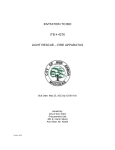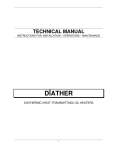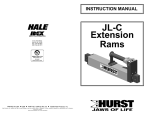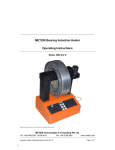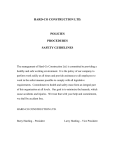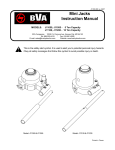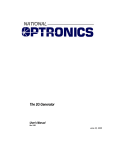Download - Hurst Jaws Of Life
Transcript
INSTRUCTION MANUAL MOC Combination Tool RESCUE TOOLS PRODUCT SAFETY POLICY Jaws of Life © products are designed and manufactured to provide excellent service when used for their intended purpose. Operator safety is a major consideration in the product design and operator manuals are provided to promote their safe usage. Additionally, operator training programs are offered by all authorized Jaws of Life Distributors and this company. Power units and tools should be operated by qualified personnel only. Proper protective clothing should be worn. (i.e. bunker gear, gloves, helmets, face shields, etc.) Hale Products, Inc. urges all users of Jaws of Life products to read the Instruction Manual and to seek operating instructions from qualified instructors before attempting to use the products. Although most safety precautions are addressed in factory authorized training programs, as well as throughout this manual, particular attention is directed to the following: When removing the tool from a multi-tool circuit, be sure the other tools are not in use and the dump valve is in the "closed" position before disconnecting unit. Inspect the equipment for obvious broken or missing parts or damaged hoses before and after use. Be sure to follow all maintenance procedures. Keep clear of all moving parts. Use only factory authorized service parts. When pulling, keep clear of chains. Use only Jaws of Life fire resistant hydraulic fluid.* Do not substitute other brands of hydraulic fluid because characteristics may differ. Fluid such as brake fluid or automatic transmission fluid will not work in the Jaws of Life system and will damage the equipment. When lifting, always use cribbing to shore and stabilize the object being lifted. When storing tool, compensate for possible pressure buildup from thermal expansion of hydraulic fluid by connecting the two short hoses on the tool, completing the circuit. Move trigger in both directions to equalize the pressure on both sides of the piston. Return your warranty registration card. Ear protection should be worn when operating the 2-cycle and 4-cycle units. HYDRAULIC FLUID: Jaws Of Life® hydraulic fluid* is a custom blended phosphate ester fluid. In case of skin contact, wash off with soap and water. In case of eye contact, flush with generous amounts of running water. If discomfort persists following flushing, see physician for symptomatic treatment. DO NOT OPERATE EQUIPMENT WHEN TIRED, STAY ALERT. *Solutia product name MCS-2361 - MSDS on file. 1 Assembly / Storage MOC Combi-Tool 1 Remove rescue tool from carton; inspect unit and confirm that all bolts and screws are securely fastened, and the unit has not been damaged in shipment. 2 Before starting the hydraulic power unit, connect the hoses from the power unit to the tool as shown. 2 3 To operate the quick disconnect couplings, align the slot in the sleeve with the pin. Slide the sleeve back to connect or disconnect the coupling. After connecting coupling, rotate the sleeve one-quarter to one-half of a turn to lock the coupling. 4 5 Refer to the applicable power unit manual, start the power unit and apply hydraulic pressure to the tool. Operate the tool by moving the star grip control valve to the LEFT to OPEN the blades, and to the RIGHT to CLOSE the blades. If the tool does not operate correctly, make sure the quick disconnects are properly connected as per step 3, then, if needed, refer to the trouble-shooting section of this manual. To OPEN: Move star grip control to the LEFT. To CLOSE: Move star grip control to the RIGHT. For initial start-up and after service or maintenance, open and close the tool several times to purge air from the system. 3 6 To attach optional chain and shackle accessories for pulling operation, slip tips over the ends of the blades until they are secure. Make sure both hooks are facing the same direction, up or down, to prevent the arms from twisting. Proper assembly shown. Refer to the instructions supplied with the 364C018 - KSV 11 Chain Set for additional information. 7 After use, position the blades to a slightly open position for storage. Remove hydraulic pressure from the tool. Move the thumb control in both directions to equalize the pressure. Disconnect the tool from the power unit and connect the two short hoses (pigtails) of the tool to each other. For storage, protect unit from moisture or store in moisture-free location. Secure in adequate storage space to prevent tool damage and kinking of the hoses. 8 Should you need to contact us about your Rescue Tool, refer to the tool serial number (found on the tool as shown). This identification will expedite any service you may require and will also enable us to keep your records current. 4 Spreading / Pulling MOC Combi-Tool 1 To lift a steering column: 5 a) Open blades to maximum spread. b) Place shackles over the blade tips, see page 4, step 6. c) Wrap chain around the steering column and slip hook over the chain. d) Using the above method, attach the other chain to the body frame under the bumper. Attach the opposite end of the chain to the shackle. Make sure both hooks are facing in the same direction to prevent the arms from twisting. e) With the rescue tool resting on the car hood, adjust chain length at the shackle to remove all slack from the chains. 2 3 Lift steering column by closing the tool. If the steering column has not been pulled far enough away from the victim when the tool jaws are fully closed, open jaws and shorten chain length by adjusting chains at the shackle until all the slack has been removed. Close the tool to pull the steering column out a greater distance from the victim. To spread an automobile door open: 1. Pinch the rear edge of the door with the blade tips. 2. Rotate the Rescue Tool towards the front of the auto to pry an opening at the rear of the door. 3. With the blades fully closed, insert the tips into the opening created in step 2. If the opening is not large enough, repeat steps 1 through 3. 4 Open the blades to spread. 6 Cutting MOC Combi-Tool 1 CAUTION: HOLD BLADES PERPENDICULAR TO THE MATERIAL BEING CUT. MATERIAL TO BE CUT MUST BE SECURE SO THAT IT CAN NOT TWIST. WARNING: IF TOOL IS NOT HELD FIRMLY OR IF THE MATERIAL IS FORCED BETWEEN THE BLADE FLATS, BLADE DAMAGE MAY RESULT. 2 CAUTION: AVOID CUTTING A LOOSE END. IF UNAVOIDABLE, BE SURE THE END OF THE OBJECT TO BE CUT IS SECURE. WARNING: DO NOT CUT CABLES UNDER TENSION. DO NOT CUT ELECTRICAL WIRES UNLESS ABSOLUTELY CERTAIN THAT ALL ELECTRICAL POWER HAS BEEN REMOVED. The blades are designed to cut sheet metal such as door posts and roofs. Visually inspect area to be cut for obstacles such as seatbelt bolts, stiffener plates, etc. 7 3 To cut, open tool. Place blades around object. Close tool to cut object. Maximum cutting forces are obtained at the portion of the blade nearest the blade pin or center pivot pin. When possible, start your cut at this point. After making cut, open blades to remove tool. CAUTION: PROTECT VICTIM AND OPERATOR FROM GLASS. 8 TROUBLESHOOTING AND GENERAL MAINTENANCE GENERAL MAINTENANCE GUIDE* DAILY MAINTENANCE/INSPECTION Inspect carefully for Hydraulic leaks Inspect hoses and couplings for wear and damage. Clean unit with soap and water Check hydraulic fluid level in reservoir and fill if necessary. Use only HURST PHOSPHATE ESTER hydraulic fluid. Use of any other fluid will damage seals in Hurst equipment. Check that all fasteners are in place and securely fastened. AFTER USE MAINTENANCE Clean unit. Check hydraulic fluid level in reservoir and fill if necessary. 6 MONTH MAINTENANCE Check hoses and coupling for wear and damage. Replace if necessary Replace operating decals as required Clean unit with soap and water. STORAGE Protect unit against moisture. Store in adequate space to prevent damage to unit. * Call your authorized Jaws of Life Distributor for maintenance and annual inspection care. ANNUAL INSPECTION* NOTE: ANNUAL INSPECTION SHOULD ONLY BE PERFORMED BY FACTORY PERSONNEL OR FACTORY TRAINED PERSONNEL. Disassemble and inspect all parts and seals for wear or damage. Replace as necessary. Reassemble and check hydraulic pressure. Hydraulic pressure should be 5000 PSI. Test unit with and without load and check for hydraulic leaks. Replace operating decals as needed. Replace hoses, couplings and fasteners as required. Clean unit with soap and water. TROUBLESHOOTING GUIDE* PROBLEM Tool operates erratically, slowly or fails to operate. CAUSE REMEDY Hydraulic Fluid is low Air in Hydraulic System Valve thumb control lever is loose Check fluid level in reservoir and add fluids as required Fully open and close tool several times. Tighten or replace screw on thumb control lever, or replace thumb control lever assembly as required. Have power unit repaired.* Have power unit repaired.* Low flow from power unit Erratic flow from power unit Tool fails to operate Engine Hard to start or fails to start Couplings not properly connected Coupling failure - fails to open internal check when connected No flow from Power Unit Hoses Reversed on power unit Couplings reversed on tool Connect couplings correctly (See page 3, section 3) Remove and replace coupling Check power unit and repair as required. Remove and reverse hoses Remove and reverse couplings No Fuel in tank Fuel line or filter clogged Engine flooded Spark plug wire shorted, broken or disconnected * Call your authorized Jaws of Life Distributor for maintenance and annual inspection care. 9 NOTES: 10 PRINTED IN USA 0407 PART NO. 159R173 REV. 01 ©2007 Hale Products, Inc. A Hale Products, Inc. reserves the right to make changes at any time, without notice or obligation, in prices, materials, equipment or specifications and to change or discontinue models. Check with distributor for current information.












